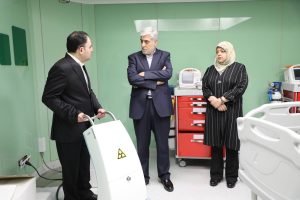
Epidemiology & social-economic impacts of cardiovascular diseases increasing
Barekat Health & Pharmaceutical Group: Cardiovascular diseases are recognized as one of the leading causes of death worldwide, and Iran is no exception. Over the past two decades, there has been a significant increase in the prevalence of these diseases in Iran, which can be attributed to numerous factors, including lifestyle changes, environmental conditions, and genetic predispositions.
Lifestyle changes such as increased consumption of fatty and fast foods, reduced physical activity, elevated stress and anxiety levels, and higher rates of tobacco and alcohol use have all played a significant role in the rise of cardiovascular diseases. Additionally, environmental factors like air pollution and reduced access to green spaces have also contributed to the growing incidence of these conditions.
Genetic and epigenetic changes also play a crucial role in increasing the risk of cardiovascular diseases. With recent advancements in genetics, investigating the role of genetic factors in the development of cardiovascular diseases, particularly among specific populations like Iranians, has gained significant importance.
This report delves into the epidemiology and socioeconomic impacts of the rising prevalence of cardiovascular diseases in Iran. It provides an analysis of the causes and consequences of this increase, along with recommendations for mitigating its negative effects on Iranian society and the economy.
Epidemiological Analysis:
Lifestyle Changes
In recent years, there have been major shifts in the lifestyle of Iranians, many of which have contributed to the rise of cardiovascular diseases.
– Dietary Changes: Increased consumption of fatty, processed foods, reduced intake of fruits and vegetables, and excessive use of salt and sugar are directly linked to the heightened risk of cardiovascular diseases. Notably, the consumption of fast foods and ready-made meals has significantly surged due to ease of access and widespread advertising.
– Reduced Physical Activity: Urbanization and increased reliance on personal vehicles instead of walking or cycling, coupled with a decline in sports activities among the youth and prolonged hours of sedentary work, have all led to higher obesity rates and declining cardiovascular health.
– Increased Stress and Anxiety: The economic and social conditions in recent years have contributed to rising levels of stress and anxiety among Iranians. Stress is known as a risk factor for cardiovascular diseases, with a direct link to increased blood pressure and heart attacks.
Environmental Factors
– Air Pollution: Studies have shown that air pollution is a major factor in the rise of cardiovascular diseases. In major Iranian cities such as Tehran, the high levels of air pollution are directly correlated with an increase in cardiovascular disease incidence.
– Reduced Access to Green Spaces: The reduction in green spaces and limited opportunities for outdoor recreational activities, especially in urban areas, is another environmental factor contributing to the rise in cardiovascular diseases in Iran.
Genetic & Epigenetic Factors
– Genetic Factors: Research indicates that genetic factors can significantly increase the risk of cardiovascular diseases. In Iran, the presence of certain specific genetic mutations within the population increases the likelihood of developing these conditions.
– Epigenetic Factors: Beyond genetic influences, epigenetic factors also play a significant role in the onset of cardiovascular diseases. These include changes in gene expression due to factors like nutrition, stress, and environmental conditions, which can elevate the risk of these diseases.
Social Impacts
– Increased Disability and Reduced Quality of Life**: Cardiovascular diseases not only lead to mortality but also cause physical and mental disabilities that severely reduce individuals’ quality of life. These diseases can diminish work capacity and everyday activities, increase the need for healthcare and medical attention, and create greater dependence on family and the healthcare system.
– Changes in Family Dynamics: The rise in cardiovascular diseases can lead to changes in family structure and dynamics. Individuals suffering from these conditions may require greater support from family members, which can impose additional pressures on families.
– Social Burden of Disease: In addition to its direct impact on affected individuals, cardiovascular diseases impose a significant burden on society as a whole. As the number of people affected increases, so does the need for supportive and healthcare services, potentially exacerbating social inequalities. Those lacking financial resources or sufficient access to healthcare services may face worse outcomes, contributing to widening social and economic disparities.
– Impact on Education: Cardiovascular diseases can affect education through their impact on the health of parents or even students. Children from families affected by these diseases may drop out of school due to the need to care for ill parents or financial difficulties stemming from healthcare costs, leading to reduced educational attainment and higher dropout rates, particularly in disadvantaged areas.
Economic Impacts
– Increased Healthcare Costs: Treating cardiovascular diseases requires specialized and advanced care, imposing significant costs on the country’s healthcare system. These costs include hospitalizations, cardiac surgeries, long-term medications, and post-surgical care.
– Reduced Workforce Productivity: The rise of cardiovascular diseases can lead to reduced workforce productivity due to increased absenteeism, diminished work capacity, and physical and mental disabilities. This, in turn, can negatively affect the national economy and impede economic growth.
– Financial Strain on Families: In addition to direct healthcare costs, families may face indirect costs such as reduced income, increased caregiving expenses, and the need to change jobs or reduce working hours. These financial burdens can severely strain families and even lead to a decline in their economic status.
– Impact on the Insurance System: The increasing prevalence of cardiovascular diseases puts additional pressure on healthcare insurance systems. As more individuals are affected, insurance payouts rise, potentially leading to higher premiums and a reduced ability for insurers to cover costs. This may result in lower access to healthcare services for individuals.
Solutions & Recommendations
To combat the rising prevalence of cardiovascular diseases in Iran and reduce their negative impacts on society and the economy, several measures can be proposed:
Public Education and Prevention Programs
– Public Awareness: Increase public awareness about risk factors and methods of preventing cardiovascular diseases through educational programs in the media, schools, and healthcare centers. Teaching the importance of a healthy diet, physical activity, and stress management can help reduce the prevalence of these diseases.
– Promotion of Physical Activity: Develop urban infrastructure to encourage walking, cycling, and group sports. This can include creating local parks, walking and cycling paths, and community sports programs.
Public Health and Policy Reforms
– Food Policy Reforms: The government can improve public nutrition by imposing stricter regulations on the production and distribution of fatty and sugary foods. Supporting the production and distribution of healthy, organic foods can also be an effective step in reducing the prevalence of cardiovascular diseases.
– Reducing Air Pollution: Enforce stricter policies to control air pollution, particularly in urban areas. This can include stronger restrictions on the use of private vehicles, promoting public transportation, and encouraging the use of clean energy.
Research and Development
– Genetic and Epigenetic Research: Support research into identifying the genetic and epigenetic factors that contribute to cardiovascular diseases. This research can aid in developing new diagnostic and treatment methods and lead to more effective prevention strategies.
– Use of Advanced Technologies*: Develop and use modern technologies such as artificial intelligence and big data to analyze healthcare data and identify patterns in the prevalence of cardiovascular diseases. These technologies can improve healthcare planning and treatment strategies.
Conclusion
Cardiovascular diseases are on the rise in Iran due to various factors such as lifestyle changes, environmental influences, and genetic predispositions. These diseases have wide-ranging impacts on individual health, as well as on the social and economic fabric of the country. By implementing preventive policies, improving healthcare infrastructure, and supporting scientific research, it is possible to reduce the prevalence of these diseases and improve the quality of life for the Iranian population.
Timely attention to this issue can not only improve public health but also prevent the socioeconomic pressures associated with the growing burden of cardiovascular diseases.
The increasing prevalence of cardiovascular diseases in Iran is due to a combination of lifestyle changes, environmental factors, and genetic predispositions. The socioeconomic impacts of these diseases are substantial, affecting not only individual health but also family structures and the national economy. To address this challenge, comprehensive approaches in public health, education, and socioeconomic policies are essential. Preventive measures, improved environmental conditions, and increased public awareness can help curb the rise of cardiovascular diseases in Iran.
-
Barkat Group specialized meeting

-
Safa Appointed as Barekat General Director

-
Barekat Health & Pharmaceutical Group at the 10th Iran Pharma Exhibition

-
Ali Safa visits Sobhan Oncology & Sobhan Darou

-
Pirsalehi & Safa visit Saman Daroo 8 Knowledge-based Company

-
Barekat Managing Director Visits Samen Pharmaceutical Company

-
Honoring Pharmacists’ Day

-
Barekat Top Executives Visiting to Barekat Hospital

